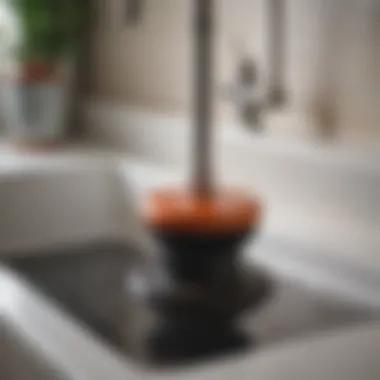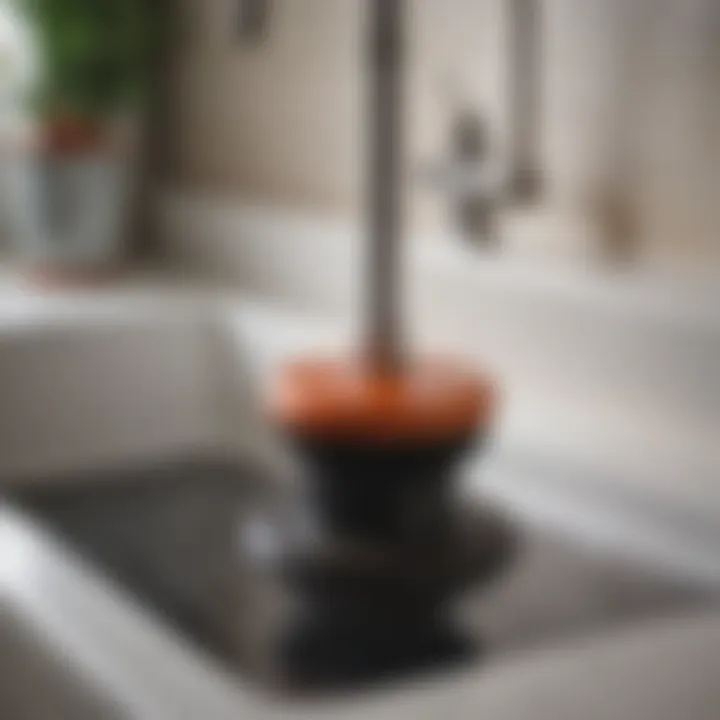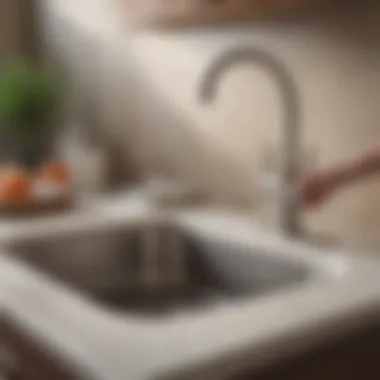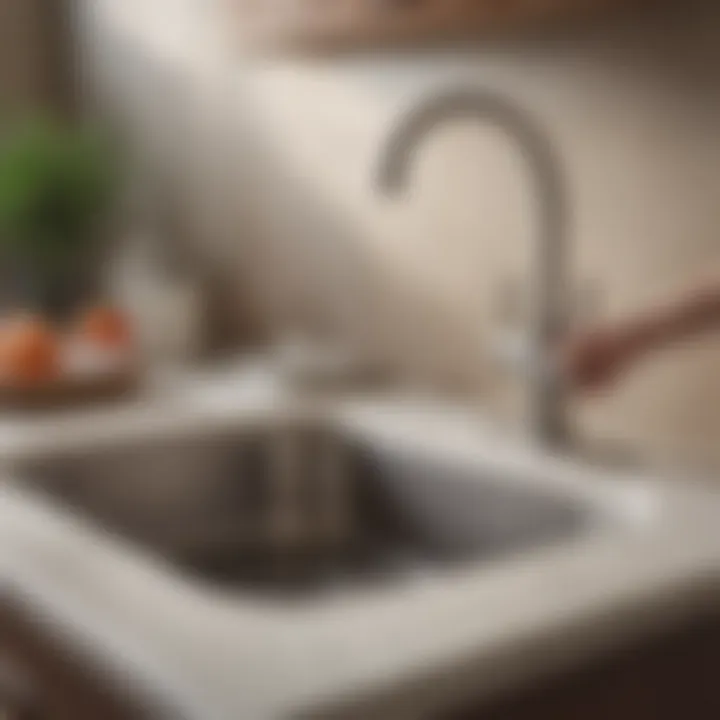Effective Techniques for Unclogging Kitchen Sinks


Intro
Unclogging a kitchen sink can be a frustrating task. Many homeowners face this issue at some point, and knowing how to address it effectively can save time and money. A plunger is often the first tool that comes to mind for tackling a clogged sink. But how effective is it, really?
This article provides an in-depth examination of using a plunger as a method for unclogging kitchen sinks. We will explore the mechanics of such clogs, evaluate the effectiveness of plungers compared to other methods, and provide practical insights into proper techniques. Moreover, we will look at the limitations of plungers and discuss alternative solutions for various types of clogs. This information will serve homeowners, design enthusiasts, and those encountering plumbing challenges in their spaces.
Understanding Kitchen Sink Clogs
Kitchen sink clogs can disrupt daily life, creating inconvenience and frustration. Understanding the nature of these clogs is essential for homeowners and individuals responsible for kitchen maintenance. Knowing common causes and types of blockages can assist in preventing future issues. This section presents a detailed look into the factors and characteristics contributing to sink clogs, laying the groundwork for effective unclogging methods using a plunger.
Common Causes of Clogs
Identifying common culprits behind clogs is vital for prevention and resolution. This section will break down significant factors that lead to clogs in kitchen sinks.
Food particles
Food particles often collect in the drain over time, reducing the flow of water. When food pieces are washed down the sink, they can easily stick to the walls of pipes, quickly contributing to blockages. This is a common issue in households, primarily because many people underestimate the impact of small particles combined with water. The key characteristic of food particles is their organic nature, which can lead to degradation and build-up in plumbing. Addressing this type of clog early can prevent more serious blockages, making it crucial for homeowners to recognize.
Grease accumulation
Grease is another primary cause of sink clogs. When food is cooked, oil and fats are released into the sink. These substances can solidify in pipes as they cool, creating significant clogging issues. The unique feature of grease is its ability to combine with other debris like food particles, leading to even larger blockages. This issue often goes unnoticed until significant drainage problems arise. It is a disadvantage because it requires more thorough cleaning to resolve.
Foreign objects
Foreign objects, ranging from utensils to small toys, can easily find their way into the sink drain, leading to immediate clogs. This type of clog can be particularly challenging because it may require physical removal of the item. The key characteristic of foreign objects is their unexpected nature, often surprising homeowners. Understanding that foreign items can obstruct drainage underscores the need for caution in what goes down the sink.
Types of Clogs
Clogs vary by severity and type. Recognizing these differences can guide homeowners in choosing appropriate solutions, enhancing the utility of a plunger effectively.
Partial blockages
Partial blockages occur when water drains slowly but does not stop entirely. This situation may allow for some drainage while causing inconvenience. The key characteristic of partial blockages is their ability to gradually worsen or improve, depending on the maintenance of the sink. Addressing partial blockages quickly can prevent them from developing into more serious issues. They often respond well to plunging techniques.
Complete blockages
Complete blockages prevent water from draining at all. This severe situation demands immediate attention and can result in unpleasant odors and water backups. The unique feature of complete blockages is that they often signal deeper plumbing issues that require thorough investigation. Homeowners should be cautious, as using a plunger without proper diagnosis can lead to further problems. In some cases, the assistance of professionals may be necessary.
Diagnosing the Clog
Recognizing the symptoms of a clog is essential for effective remediation. Two significant assessment techniques are sink behavior assessment and understanding water drainage patterns.
Sink behavior assessment
Observing sink behavior is a crucial first step in diagnosis. This involves noting whether water drains slowly or not at all and checking for unusual noises. Understanding these behaviors helps pinpoint the source and nature of the clog. The key characteristic here is that noted changes in sink functionality often precede major blockages. Early assessment can lead to timely action, aiding in effective unclogging with a plunger.
Water drainage patterns


Examining water drainage patterns provides insight into the severity and location of the blockage. Homeowners can observe if water pools at certain times or drains sporadically. Recognizing these patterns helps in identifying whether the clog is localized or indicative of a more widespread plumbing issue. This form of diagnosis is beneficial because it allows for strategic clog management rather than trial-and-error attempts.
This overview of kitchen sink clogs sets the stage for understanding how to effectively use a plunger to tackle these common household issues. By recognizing causes and evaluating types of clogs and their symptoms, individuals position themselves to act more knowledgeably when faced with plumbing dilemmas.
The Plunger: A Tool for the Task
The plunger serves as a vital instrument in the effort to clear kitchen sink clogs. Understanding the different types, mechanics, and techniques associated with plungers can significantly enhance one's effectiveness when tackling household plumbing issues. This section will discuss the various elements of plungers, highlighting their unique characteristics and practical advantages.
Types of Plungers
Standard cup plungers
Standard cup plungers are perhaps the most commonly used type. Their simple design consists of a rubber suction cup attached to a straight wooden or plastic handle. This simplicity allows for ease of use, making them accessible for many homeowners. The key characteristic of standard cup plungers is their effectiveness in clearing minor to moderate clogs. They excel particularly in sinks where the drain is not excessively obstructed.
Unique features of standard cup plungers include their lightweight nature and affordability. However, there are some limitations. They might struggle with more stubborn clogs, especially in cases where foreign objects are involved. Users should be aware that while standard cup plungers can be quite effective, relying solely on them for all clogs can be problematic.
Flange plungers
Flange plungers, on the other hand, have a distinctive design suited for specific situations. They feature an extended rubber flap, or flange, which creates a tighter seal. This characteristic makes flange plungers more effective in toilets and deeper sinks. Their ability to generate increased suction allows users to remove hard-to-reach clogs that might resist a standard cup plunger.
The unique feature of flange plungers is their adaptability, allowing for both suction and pushing motions. This versatility is advantageous when faced with varying types of clogs. However, they might not be the first choice for every situation, especially in shallower sinks where the standard cup plunger would suffice for effective use.
Mechanics of a Plunger
Creating suction
Creating suction is the fundamental action that underpins the plunger's effectiveness. This process involves pressing the rubber end of the plunger against the sink drain to form an airtight seal. The importance of proper suction cannot be overstated; it is essential for successfully dislodging clogs. When the user pushes and pulls the plunger, they create a pressure difference that helps to break up the blockage.
The key characteristic of creating suction is that it directly influences the plunger's ability to clear a clog. Suction-based techniques are simple yet powerful because, with the correct motion, users can often achieve immediate results. However, if the seal is not complete, suction will be inefficient. This potential drawback underlines the importance of ensuring a good fit before starting the plunging process.
Pressure application
Pressure application is another crucial aspect of using a plunger. It involves the rhythmic pushing and pulling of the handle to change the pressure in the plumbing line, effectively working to push the clog through. The key characteristic of this technique is that it combines both suction and pressure to maximize effectiveness.
Applying pressure can benefit users by allowing them to tackle tougher clogs, which might resist mere suction. However, it is also important not to overdo it, as excessive force might create a risk of damaging plumbing fixtures. Understanding the balance between pressure and suction will enhance the effectiveness of the plunger when unclogging.
Proper Plunging Techniques
Assessing sink type
Before engaging in the plunging process, it is essential to assess the type of sink in question. Different sinks, such as double-basin models or those with a garbage disposal system, will require tailored approaches. This assessment is a significant step toward success, as the strategy may vary for each configuration.
The key characteristic in this assessment process is recognizing that not all sinks respond the same way to plunging. Each type may require different techniques to achieve optimal results. Understanding sink types will help users identify the best tools and methods for effective clog removal, thus avoiding unnecessary frustration.
Effective plunging motion
The effective plunging motion involves a consistent and rhythmic action that optimizes both suction and pressure to clear the blockage. The key characteristic of this motion is that it should be deliberate—pushing down with force and then pulling up without breaking the seal. Consistency here can significantly impact overall effectiveness.


Users will discover that the right technique requires familiarity and practice. An effective plunging motion can dramatically reduce the time spent clearing clogs. However, improper technique can lead to failure, emphasizing the value of skill and precision when employing a plunger.
Effectiveness of Using a Plunger
The effectiveness of using a plunger is pivotal in resolving kitchen sink clogs. Understanding when and how to employ this tool can save time, effort, and potential expense. A plunger can be a homeowner's first line of defense against blockages, allowing for quick resolution of many common issues without the need for professional help.
However, it is essential to know the specific situations where plunging proves successful and the limitations inherent in its use. Not all clogs react favorably to a plunger, and knowing this can inform the approach one should take in dealing with sink malfunctions.
When Plunging Works
Soft clogs
Soft clogs often consist of materials that are relatively easy to dislodge. Common examples include food particles and soap buildup. Its nature means that it can be effectively addressed by the suction and pressure generated through plunging. Soft clogs represent a beneficial situation for the homeowner because they can be cleared quickly. The unique feature about soft clogs is that they usually do not require significant force to clear. Therefore, plunging becomes a highly advantageous method, as it eliminates the need for harsher interventions, such as chemicals.
Moderate blockages
Moderate blockages may occur when multiple substances combine, like grease mixed with food debris, leading to a more substantial obstruction without being completely blocked. These situations still allow for effective plunging. The key characteristic of moderate blockages is their responsiveness to the pressure exerted by a plunger. As a result, plunging can often manage these clogs well, preventing a complete blockage. Thus, plunging remains a strong choice, providing a more efficient and less invasive solution to plumbing issues.
Limitations of Plunging
Hard and stubborn clogs
Hard and stubborn clogs often entail solid materials like hair or dense grease that resist the movement generated by a plunger. Their tough composition can render a plunger ineffective. No matter how much force is applied, these clogs require alternative strategies. The key attribute of these clogs is their ability to withstand pressure, which extends the time needed for resolution and elevates frustration. Recognizing when a clog may be beyond a plunger's capability is necessary to avoid wasted effort.
Potential for further blockage
Lastly, the potential for further blockage is a significant consideration. Aggressive plunging can inadvertently push debris deeper into the pipes, creating a more significant obstruction further down the line. This risk highlights the need for understanding the plumbing system's layout and ensuring that plunging does not exacerbate existing problems. The unique aspect of this limitation is the dual nature of the tool—it can either resolve a problem or complicate it further.
It’s essential to assess the situation carefully before opting to use a plunger to avoid additional headaches down the road.
Alternatives to Plunging
Exploring alternatives to plunging is essential for effectively dealing with kitchen sink clogs. While plungers can be effective in many situations, some clogs require different approaches. Understanding these alternatives can empower homeowners to tackle kitchen sink issues without solely relying on one tool. Each method has its unique benefits and considerations that may align more closely with the type of clog being dealt with.
Using Baking Soda and Vinegar
Chemical Reaction
The combination of baking soda and vinegar is well-known for creating a fizzing chemical reaction. When mixed, baking soda's alkalinity reacts with the acetic acid in vinegar, producing carbon dioxide. This reaction can help dislodge food particles and debris within the pipes. It is a popular choice due to its non-toxic nature, making it safe for both the environment and plumbing systems.
Its key characteristic is that it is a gentle yet effective method to unclog minor blockages. A unique feature of this approach is that it does not pose a risk of damaging plumbing, unlike some harsher chemical drain cleaners. However, while this method is generally advantageous, it may not be sufficient for more stubborn or severe clogs.
How to Apply
Applying the baking soda and vinegar method involves a simple two-step process. First, pour a cup of baking soda directly into the drain. Then, follow it with a cup of vinegar. As the mixture fizzes, let it sit for about 30 minutes before flushing with hot water. This method’s simplicity is a major benefit.
Its unique feature is that it provides an easy and inexpensive solution for regular maintenance or minor clogs. However, it is essential to acknowledge that if the clog is severe, this method may not resolve the issue completely.


Plumbing Snake Techniques
How to Use a Plumbing Snake
Using a plumbing snake is an effective method for unclogging kitchen sinks, particularly for more stubborn blockages. A plumbing snake, or auger, consists of a long, flexible metal cable that can reach deep into pipes. To use a plumbing snake, insert the end into the drain and turn the handle while pushing forward, allowing the snake to navigate through the pipe to break up or retrieve debris. This technique can be highly effective for retrieving foreign objects or strong clogs that are beyond the reach of a plunger.
The key characteristic here is its ability to reach areas that plungers cannot. The flexibility of the snake allows it to navigate bends in plumbing, making it a versatile tool. However, it requires a certain level of comfort and skill to use effectively, and improper use may lead to further damage or complications.
When to Consider This Method
Considering the plumbing snake method is important when there are repeated blockages or if essential symptoms appear. Indicators such as slow draining or recurring clogs suggest that the issue may require a more thorough approach. Using the plumbing snake is beneficial for more complex situations that a plunger cannot resolve. Its unique aspect is its effectiveness for deep clogs, making it a reliable option for persistent plumbing issues. However, it may not be the first option for minor clogs, as using it improperly could lead to pipe damage.
Seeking Professional Help
Signs a Plumber is Needed
Recognizing when to call a professional plumber can save time and prevent more severe issues. Signs that indicate a plumber is needed include persistent multiple clogs, gurgling sounds from drains, or water backing up into other fixtures. These symptoms suggest that there might be a larger plumbing problem at hand.
The key characteristic of these signs is their indication of an underlying issue in the plumbing system. Addressing this before it escalates can prevent more extensive damage and costly repairs. A unique feature of this realization is that it can allow for preemptive action rather than reactive measures.
Cost Considerations
When seeking professional help, cost considerations are an important aspect. Plumbing fees can vary significantly depending on the work required, the location, and the time of service. On average, homeowners might expect to pay for the plumber's visit, plus any repairs necessary to fix the plumbing issue. Considering these aspects helps homeowners to budget correctly and avoid potential financial strain.
The key characteristic of understanding costs involves knowing what to expect and how to mitigate expenses. The unique feature here is that being proactive and addressing plumbing issues early can lead to lower long-term costs. However, neglecting small issues can lead to larger, more expensive problems.
Preventative Measures
In the context of maintaining a kitchen sink, preventative measures play a crucial role in minimizing the occurrence of clogs. By implementing effective practices, homeowners can significantly reduce the likelihood of encountering problems that require immediate attention or extensive plumbing solutions. Preventative measures not only save time and money but also contribute to a more efficient and enjoyable kitchen environment.
Regular Maintenance Practices
Routine cleaning techniques
Routine cleaning techniques focus on the regular upkeep of the kitchen sink and its surrounding area. Consistent attention to cleaning helps to prevent buildup, which can lead to clogs over time. One of the key characteristics is that these practices can be easily integrated into daily chores, making them manageable for any household. For instance, wiping down the sink with a mild cleaner prevents the accumulation of debris and grime.
The unique feature of routine cleaning is that it can significantly extend the lifespan of both the sink and its plumbing. However, it does require a consistent effort to be effective, particularly in households with high usage.
Using strainers
Using strainers is another effective method in reducing the chances of clogs in kitchen sinks. Strainers catch food particles and debris that might otherwise enter the drainage system. The key aspect of strainers is their simplicity and effectiveness in preventing larger items from causing blockages. They are a popular choice because they are affordable and easy to install. A well-designed strainer can save homeowners from the hassle of frequent unclogging.
However, the unique feature of strainers is that they require regular cleaning to ensure they do not become blocked themselves. Neglecting to clean a strainer can lead to its own issues, making it essential to keep this tool well-maintained.
Educating Household Members
Avoiding foreign objects
Educating household members about the importance of avoiding foreign objects in the sink is vital. When people are aware of what should never be put down the drain, it reduces the risk of clogs. This awareness is characterized by its proactive nature: rather than dealing with clogs after they happen, it focuses on prevention from the start. Encouraging proper practices, such as not disposing of grease or large food items, can significantly enhance the overall functionality of the kitchen sink.
The unique feature of educating about avoidance is that it fosters a collaborative approach to home maintenance, where every member takes responsibility for proper waste disposal, though it may require constant reminders to ensure adherence.
Proper waste disposal methods
Proper waste disposal methods encompass educating family or household members about what can or cannot be disposed of through the sink. This understanding goes beyond basic instructions; it fosters informed habits regarding kitchen waste management. The key characteristic of this method is that it promotes sustainable practices, contributing not only to the sink's efficient operation but also to the overall health of plumbing systems.
The unique feature of these methods lies in their long-term benefits. When everyone is informed on proper disposal practices, it can lead to lasting changes in behavior. However, this approach can be challenging, as changing habits often takes time and persistence.
"Taking the time to educate your household about kitchen upkeep can lead to fewer clogs and a more pleasant kitchen experience."
Overall, implementing preventative measures is essential for maintaining kitchen sinks. Consistent maintenance and education create a more efficient household and prevent the frustration of clogs down the line.







